M4 and M4A1 Medium Tanks of the 752nd
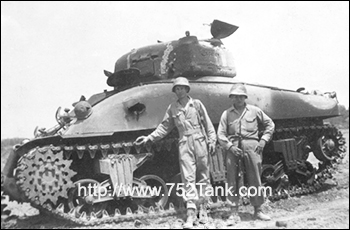 |
| There was previously some doubt as to whether this B Company M4A1 was lost at Rome or at Rosignano. Newly surfaced civilian photos clearly reveal that this was one of the four B Company 2nd Platoon tanks knocked out in combat on 12 July 1944 near Rosignano. An 88mm shell entered on the far side of the tank at the assistant driver's position, and went clear through the tank and exited at the driver's position. Both men were killed. |
- Researched and Written by Robert Holt -
The 752nd Tank Battalion operated a mixed force of M4 and M4A1 tanks in combat until late February 1945, when it received a full compliment of 76mm M4A3 tanks. Both the M4s and M4A1s represented a mix of equipment variations, including the random use of cheek armor and applique armor, as well as variations in transmission covers, track blocks, bogie wheels, track return rollers, sprocket plates, storage expedients, etc. All of the M4s and M4A1s in service with the 752nd throughout the entire war were equipped with small drivers' hatches, the old M34 gun mantlet, the low bustle turret, and no loader's hatch.
Spring,
Summer, & Early Autumn 1944
Through the early Autumn of 1944, the M4s and M4A1s of the 752nd were
notably void of markings. Some of the M4s and M4A1s were
camouflage-painted, but while this was common in the 752nd, it was not
standardized within the battalion. Some, but not all of these tanks
carried their Army registration number in the standard location on the
sponsons. During the early combat period, the battalion's M4 and M4A1
tanks did not make use of any Allied stars on their vertical surfaces.
It is not known for certain whether any Allied stars were present on
the top surfaces to aid in air recognition. However, the few "high
angle" photos that do exist suggest that no air recognition stars were
used on 752nd tanks during this period.
Remarkably, the 752nd's tanks of this period did not utilize the bumper codes required by regulations. Only a small handful of photos hint at the use of bumper codes through early Autumn 1944, but these codes were quite crude and certainly inconsistent with regulations. These crude bumper codes appear as the large numerals 5A 752Δ, centered above the transmission cover rather than on the vehicle's right side per regulations. There was no corresponding vehicle number as part of the code, although some vehicles did carry a small tactical number of non-regulation design (discussed below).
The most prominent markings on the tanks of this era were one or two-digit tactical numbers denoting the platoon and vehicle number. Tanks 1-5 comprised the 1st Platoon, 6-10 the 2nd Platoon, and 11-15 the 3rd Platoon. As shown in the photos below, the M4A1s of "B" Company carried large tactical numbers on their left rear hull plate, and on the rear surface of the turret bustle. These large tactical numbers were white numerals, very thinly outlined in what appears to be black. This basic scheme appears to have been standard at least on the M4A1s of B Company, but the practice does not seem to have been rigidly followed on the welded-hull M4s of this period, even in "B" Company. Though photographic evidence is limited, it appears that when the other medium companies did use large tactical numbers, they appeared only on the rear turret bustle and not on the rear hull plate.
Some 752nd B Company vets claim that their large tactical numbers were color-coded by company, with red for "A" Company, white for "B" Company, and blue for "C" Company. There seems to be some truth to this, since a "C" Company photo of an M4 shows a dark-colored tactical number on the rear of the turret bustle, as does also a tank believed to be from "A" Company. The M4A1s shown here with the large tactical numbers are all from "B" Company, hence the white tactical numbers.
On the front of the vehicle, a much smaller tactical number appeared just below the horizontal transmission bolt strip, and roughly centered with the driver's hatch. This number was olive drab on a small white square, providing a "reverse" look. This square was large enough to span two adjacent bolts on the transmission bolt strip. There is some photographic evidence that these small tactical numbers were used on the fronts of vehicles in the other companies during this period. In those few cases where the crude bumper code was present (as discussed above), the vehicle retained its small tactical number on the driver's side. However, the small white tactical square containing the vehicle number was not standardized even during the early combat period. Some early vehicles have no vehicle number on the front, and some during this period show a more "expected" white numeral printed against the olive drab hull (but without the company letter as a prefix).
- May 1944 - September 1944 -
 |
 |
 |
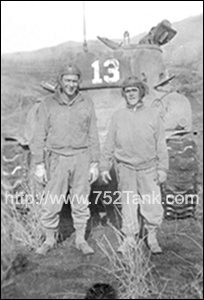 |
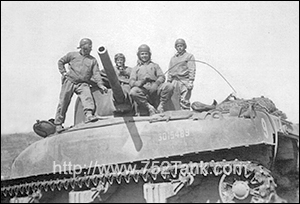 |
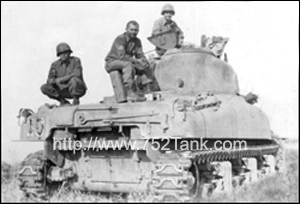 |
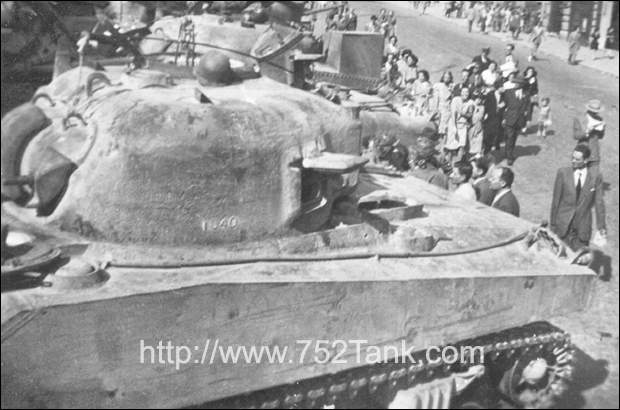 |
 |
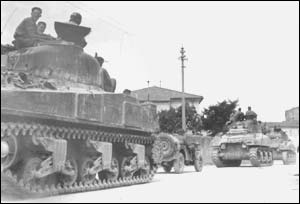 |
|
 |
 |
|
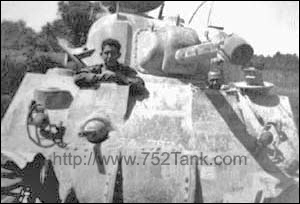 |
 |
Late
Autumn 1944 & Early Winter 1945
Whatever little standardization that had existed in the 752nd during
the early combat period seems to have been lost as the war progressed.
By mid July 1944, the 752nd had already lost 26 tanks in combat, thus
forcing a turnover of about half the battalion's tanks. Replacement
vehicles were hastily drawn from ordnance motor pools. In all cases,
the 752nd drew replacement vehicles that had previously been exchanged
by another unit for repairs due to combat damage or relatively major
mechanical problems.
As a result, the 752nd saw an influx of vehicles that already contained some form of markings from their prior unit. The most notable difference was in the more prevalent use of Allied stars, all of which included the "circle" design. It is not known whether the 752nd painted their own stars on existing vehicles, or if the stars were on vehicles obtained from other units, but it does appear that the majority of tanks did have the Allied star during the static fighting in the Apennine mountains.
While some M4s and M4A1s in this later period still retained the crude "large-letter" 5A 752Δ bumper code described above, there is also some evidence of more standard bumper codes in use. Also, nicknames appeared more commonly on the tanks during this period.
Camouflage paint schemes seem to have disappeared with the change of seasons in the snowy Apennine mountains. There is at least one photo that shows the use of whitewash as camouflage paint. However, the 752nd more commonly draped its M4 and M4A1 tanks in olive drab tarps or even in white bed linens while they operated in static locations.
From an equipment standpoint, all of the M4s and M4A1s in the 752nd still reflected the early to mid production varieties, characterized by low bustle turrets and the old M34 gun mantlets.
- Late Autumn 1944 & Early Winter 1945 -
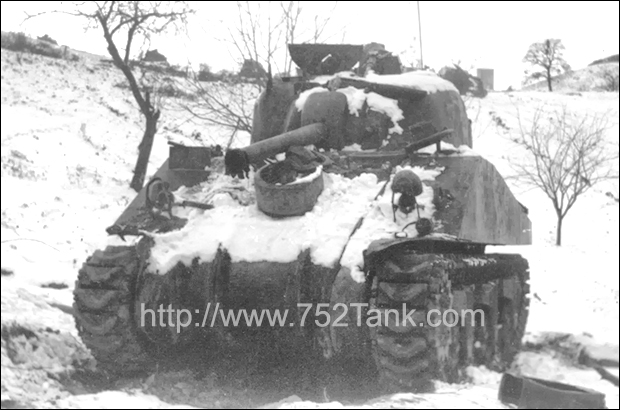 |
 |
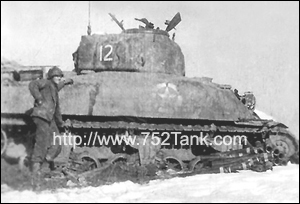 |
|
 |
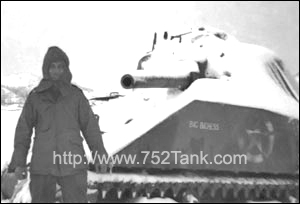 |
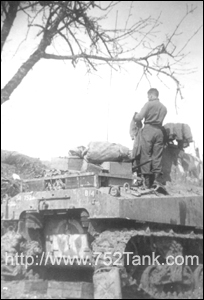 |
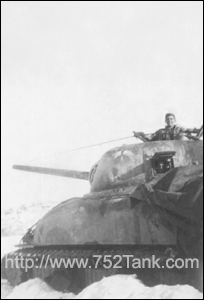 |
 |
M4A3 76mm Sherman Medium Tanks
M3/M5 Stuart & M24 Chaffee Light Tanks
Back to Top of Page
Researched by Robert J. Holt
Page Content Copyright 2006 - 2025 Robert J. Holt
All Rights Reserved